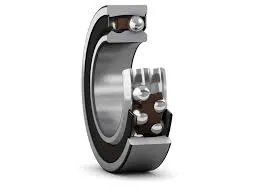
Dec . 11, 2024 10:07 Back to list
Dimensions and Specifications of Tapered Roller Bearings for Optimal Performance
Understanding Taper Roller Bearing Dimensions
Taper roller bearings are an essential component in various mechanical systems, providing support for both radial and axial loads. These bearings are characterized by their conical shape, which allows them to accommodate heavy loads while offering low friction and high efficiency. Understanding the dimensions of taper roller bearings is crucial for selecting the right bearing for an application. This article will delve into the key dimensions and specifications of taper roller bearings.
Basic Dimensions of Taper Roller Bearings
The main dimensions that define taper roller bearings include the outer diameter (OD), inner diameter (ID), and width (W). Each of these dimensions plays a critical role in the bearing's performance.
1. Outer Diameter (OD) This is the total diameter of the outer ring. The OD influences the bearing's load-carrying capacity. A larger OD can typically support larger loads, making it crucial for heavy-duty applications.
2. Inner Diameter (ID) The inner diameter is the diameter of the inner ring. It is important to match the ID with the shaft's diameter to ensure a proper fit. This fit minimizes vibration and enhances the overall performance of the bearing.
3. Width (W) Width refers to the thickness of the bearing between the two rings. A wider bearing can provide greater load capacity, but it may also add to the weight and space constraints in a design. The width must be considered in relation to both the outer and inner diameters to maintain balance and performance.
Other Important Dimensions
In addition to the basic dimensions, there are also several other specifications that are vital when choosing taper roller bearings
- Cone Width The width of the inner raceway. This dimension affects how much load the bearing can manage. A wider cone width generally contributes to increased load capacity.
taper roller bearing dimensions

- Cup Depth The depth of the outer raceway, which is crucial for ensuring the overall stability of the bearing assembly. Insufficient depth can lead to premature wear and failure.
- Pitch Diameter This is the diameter at which the bearing components engage with one another. It influences the direction and magnitude of the bearing's load capacity.
- Contact Angle This refers to the angle formed between the line of action (load) and the line drawn between the centers of the rollers and races. A larger contact angle improves axial load carrying capacity but may reduce radial load capacity.
Taper Roller Bearing Series
Taper roller bearings come in various series as defined by industry standards. Each series has specific dimensional standards and load ratings. For example, the 30000 series is a common standard that includes a wide range of dimensions suitable for many applications. Manufacturers often categorize their products within these series to simplify selection based on size and load requirements.
Selecting the Right Taper Roller Bearing
When selecting taper roller bearings, it's essential to consider not only the dimensions but also the load requirements, speed factors, and operational conditions. Proper dimensioning ensures the bearing operates effectively within its intended design parameters. Over- or under-specifying any dimension can result in inefficiencies, increased wear, or even catastrophic failure.
To ensure compatibility, it is also critical to refer to the bearing manufacturer’s catalogs, where you can find detailed dimensional charts and load ratings. Additionally, the use of specialized software in bearing selection can help make decisions easier and faster.
Conclusion
Taper roller bearings are vital components in many mechanical systems, and understanding their dimensions is crucial for effective application. By considering key specifications such as outer diameter, inner diameter, width, and other factors, engineers and designers can make informed decisions that enhance system performance and reliability. Proper selection and application of taper roller bearings will result in lower maintenance costs and longer equipment life, driving efficiency in various industries.
Latest news
-
Premium Deep Groove Ball Bearings | High Speed & Reliability
NewsAug.29,2025
-
Durable Scaffolding Clamps - Secure & Reliable Tube Connectors
NewsAug.28,2025
-
Common Failures in Thrust Ball Bearings and Solutions
NewsAug.22,2025
-
How Tapered Roller Bearings Can Take Shock Loads
NewsAug.22,2025
-
Angular Bearings in High-Precision Spindles
NewsAug.22,2025
-
The Impact of Misalignment on Cylindrical Roller Bearing Performance
NewsAug.22,2025
